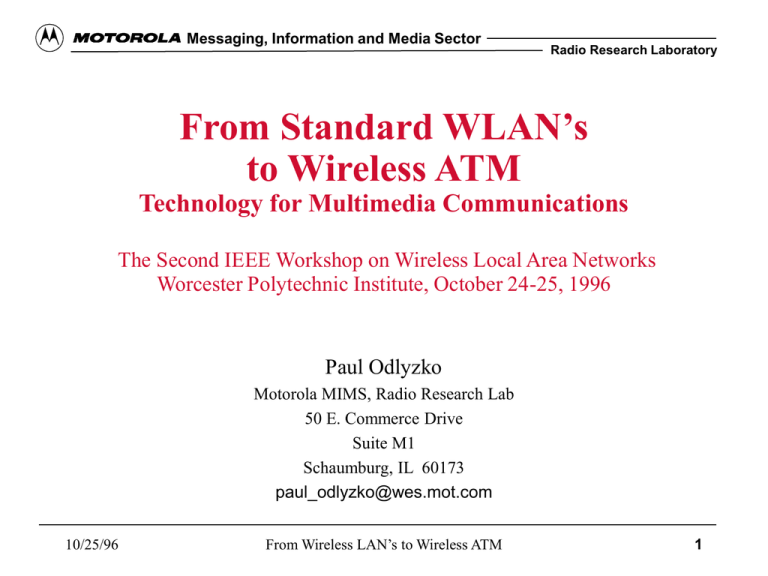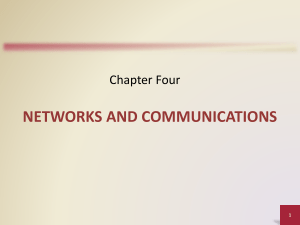From Standard WLAN’s to Wireless ATM Technology for Multimedia Communications
advertisement

Messaging, Information and Media Sector Radio Research Laboratory From Standard WLAN’s to Wireless ATM Technology for Multimedia Communications The Second IEEE Workshop on Wireless Local Area Networks Worcester Polytechnic Institute, October 24-25, 1996 Paul Odlyzko Motorola MIMS, Radio Research Lab 50 E. Commerce Drive Suite M1 Schaumburg, IL 60173 paul_odlyzko@wes.mot.com 10/25/96 From Wireless LAN’s to Wireless ATM 1 Messaging, Information and Media Sector Radio Research Laboratory Outline • What is a “standard WLAN”? • Performance goals and expectations • Architectures and applications - from LAN to Multimedia and Wireless ATM • Market perspective • Regulatory issues - unlicensed spectrum in US and Europe • Products and technology demonstrators - proprietary solutions, standards initiatives and EC-sponsored projects • HIPERLAN and 802.11 • Quality-of-Service concerns • Propagation environment - power, attenuation and multipath • Wireless ATM in the NII/SUPERNet band • Simple Asynchronous Multiple Access as etiquette and protocol 10/25/96 From Wireless LAN’s to Wireless ATM 2 Messaging, Information and Media Sector Radio Research Laboratory What is a “standard WLAN”? Infrared - history and IrDA (Infrared Data Association), laser links outdoors • ISM - FCC Part 15 Spread spectrum 902-928; 2400-2483; 5725-5825 – 1 watt, mandatory spreading – secondary use, must accept interference – Part 15.249 unrestricted for EIRP below .75 mW – “Garbage band” problems - rules practically unenforceable – need for robustness, survival • WinData duplex ISM Ethernet 2.4 GHz and 5.7 GHz, wire replacement concepts rather than mobility • 900 MHz WaveLAN from NCR, Proxim, Xircom and others 2.4 GHz systems - proprietary as well as 802.11 1997?), advertised 2 Mbps for direct sequence or hopper or hybrid possible 10/25/96 From Wireless LAN’s to Wireless ATM 3 Messaging, Information and Media Sector Radio Research Laboratory What is a “standard WLAN”? (cont’d) • “Narrow band” licensed and unlicensed – – – – Motorola-Codex project, spectrum not allocated Altair in 1990, wire replacement concepts rather than mobility, Olivetti wireless LAN based on DECT DECT branch formed in 1991 for wireless LAN leading to RES10, 5.150 GHz to 5.3 GHz, 17.1 to 17.3 GHz • New unlicensed spectrum – WINForum for 2 GHz – WINForum for 5 GHz – mmWave Etiquette Group for 60 GHz 10/25/96 UPCS NII/SuperNet From Wireless LAN’s to Wireless ATM 4 Messaging, Information and Media Sector Radio Research Laboratory Performance goals and expectations • Coexistence with wireline LANs - interfacing with competition • Ethernet 802.3 – – – – 25 Mbps ATM 30 Mbps cable (asymmetric?) 100 Mbps Gigabit movement • Sidelined wired LANs • Data rate – ISM – narrowband • Wireless ATM – RES10 talks about 50,000 ATM cells per second 10/25/96 From Wireless LAN’s to Wireless ATM 5 Messaging, Information and Media Sector Radio Research Laboratory Architectures and applications from LAN to Multimedia and Wireless ATM • Packet radio, half-duplex (TDD), • Hand-over and forwarding (HIPERLAN) • Perceived cost of infrastructure • Centralized control (“access point”) – Altair, IEEE 802.11 (BSS) • Peer-to-peer – WaveLAN, HIPERLAN (“Type 1”) • Point-to-point, point-to-multipoint 10/25/96 From Wireless LAN’s to Wireless ATM 6 Messaging, Information and Media Sector Radio Research Laboratory Market perspective • Hope for “horizontal” – Metricom (wide-area network) • Limited “vertical” markets so far – computer maintenance (ARDIS - really a WAN) - , – point of sale applications warehouses, fleet management – hence proprietary approaches are doing fine • What limits commercial success so far? commonly advanced explanations: – – – – 10/25/96 price, range, low speed, limited functionality, no “killer apps” From Wireless LAN’s to Wireless ATM 7 Messaging, Information and Media Sector Radio Research Laboratory Market perspective - cont’d • Conjectures on how the wireless LAN market will develop: – – – – access to Internet multimedia notebook computers will PDAs take off? returning motivation: cable replacement, this time for portables Open Office – tetherless nomadicity rather than fully mobile multimegabit communications • Expectations of the market: – plug-and-play for RF naive, misguided, ignorant or just oblivious users – higher expectations in-building than outdoors • Will there ever be the “year of the Wireless LAN”? – It will take a few years just as LAN networking 10/25/96 From Wireless LAN’s to Wireless ATM 8 Messaging, Information and Media Sector Radio Research Laboratory Regulatory issues • World Radio Congress; • Unlicensed spectrum in US and Europe; • FCC and CEPT; • coexistence with terrestrial microwave and satellite communications • UPCS – for 1910-1930 one end needs to be tied - until microwave users are relocated, hence suitable only for wireless PBX or such – 2390 same spectrum etiquette as 1910-1920 – coexistence for non-interoperable systems • 5 GHz first chance for world-wide market 10/25/96 From Wireless LAN’s to Wireless ATM 9 Messaging, Information and Media Sector Radio Research Laboratory Products and technology demonstrators - proprietary solutions, standards initiatives • “Mature” products: – 900 ISM proprietary systems – 2400 ISM proprietary systems – Proxim initiative (open air interface as an alternative to 802.11) • Standards-oriented developments • European projects: – – – – – 10/25/96 LAURA pre-HIPERLAN test bed HIPERION feasibility of HIPERLAN Magic Wand Wireless ATM ACTS MEDIAN From Wireless LAN’s to Wireless ATM 10 Messaging, Information and Media Sector Radio Research Laboratory HIPERLAN ETSI RES10, 5.15-5.3 GHz, 17.1-17.3 GHz • Motivation: faster is better • Process: – Transmission Techniques Group (TTG) – Control Techniques Group (CTG) – Consensus • 5 channels in 5 GHz – 5176.468 MHz lowest center frequency – 23.5294 MHz separation – 10 ppm 10/25/96 From Wireless LAN’s to Wireless ATM 11 Messaging, Information and Media Sector Radio Research Laboratory HIPERLAN equipment classes Table 28: Permissible combinations of transmitter and receiver classes Transmitter class Transmitter class Transmitter class A (+ 10 dBm) B (+ 20 dBm) C (+ 30 dBm) Receiver class A Permissible Not permissible Not permissible (- 50 dBm) Receiver class B Permissible Permissible Not permissible (- 60 dBm) Receiver class C Permissible Permissible Permissible (- 70 dBm) NOTE: The figures in parentheses indicate the nominal transmitted power (EIRPEP)or receiver sensitivity associated with each class. 10/25/96 From Wireless LAN’s to Wireless ATM 12 Messaging, Information and Media Sector Radio Research Laboratory HIPERLAN • Data burst structure – – – – High-bit-rate training sequence (450 bits GMSK at 23,529 4 Mbps) Low-bit-rate header (FSK at 1.4706 Mbps or 1:16) High-bit-rate data (GMSK) 47 or fewer blocks of 496 (416 net) bits per packet • CSMA - Non-Pre-Emptive Priority Multiple Access (NPMA) – immediate access if sensed idle for 1700 bit times – channel access resolution otherwise » prioritization » elimination » yield 10/25/96 From Wireless LAN’s to Wireless ATM 13 Messaging, Information and Media Sector Radio Research Laboratory HIPERLAN • Quality-of-Service provisions – “Best effort” basis – Priority – Packet lifetime • Uni-cast and multi-cast • Path discovery and forwarding • Power saving provisions – scheduling for p-saver and p-supporter – LBR header 10/25/96 From Wireless LAN’s to Wireless ATM 14 Messaging, Information and Media Sector Radio Research Laboratory IEEE 802.11 standard for 2400 to 2483.5 MHz (2471 to 2497 in Japan) • Physical layer – – – Frequency hopper (FH) Direct sequence (DS) Infrared (IR) 79 hopping frequencies (23 in Japan) processing gain of 11 • SCMA/CA channel access • Hopping pattern selection – sets of 26 hopping patterns • Spreading signal – 11 center frequencies defined (US) 10/25/96 From Wireless LAN’s to Wireless ATM 15 Messaging, Information and Media Sector Radio Research Laboratory IEEE 802.11 • • • • Power management Narrowband interferers Microwave ovens Quality-of-Service concept – – – – Bandwidth guarantee Data integrity Delay Delay variance • Quality-of-Service provisions – Time-bounded services – Hidden-node effect mitigation 10/25/96 From Wireless LAN’s to Wireless ATM 16 Messaging, Information and Media Sector Radio Research Laboratory Quality-of-Service Concerns • Data integrity – ARQ – FEC • Time-bounded services – Real-time voice – Video – Audio • Latency • Latency variance • Will “Standard WLAN’s” work? – Reservations re throughput with short packets – Long packet increase “jitter” 10/25/96 From Wireless LAN’s to Wireless ATM 17 Messaging, Information and Media Sector Radio Research Laboratory Propagation environment power, attenuation and multipath • Inverse relationship between distance and data rate • Power constraints • Antenna gain constraints- definitions • Models of attenuation indoors – exponent 3 to 4 – free space and walls • Optical analogy increasingly applicable with higher frequencies 10/25/96 From Wireless LAN’s to Wireless ATM 18 Messaging, Information and Media Sector Radio Research Laboratory WATM for NII/SUPERNet 5.100-5.350 and 5.725-5.875 GHz • Proposals from WINForum and Apple not restrictive • Notice of Proposed Rule Making FCC 96-193 opens dialogue • Spectrum sharing etiquette expectations: – enabling high QoS systems – flexibility for multi-media communications • Need for alternatives to support Wireless ATM – ATM cell: the byte of the 90’s – individual ATM cells – trains of ATM cells 10/25/96 From Wireless LAN’s to Wireless ATM 19 Messaging, Information and Media Sector Radio Research Laboratory Assumptions • A radio channel is most efficiently shared among users with CBR requirements. • Over any sufficiently short period of time (Tc), any bandwidth requirement is CBR. • The practical lower limit to Tc is the amount of time and overhead required to re-acquire bandwidth. • Statistical multiplexing, within a multi-service device, increases Tc. • Multi-Media devices will require protocols that support both infrastructure based (centrally controlled) and non-infrastructure based (ad-hoc) networks. 10/25/96 From Wireless LAN’s to Wireless ATM 20 Messaging, Information and Media Sector Radio Research Laboratory Desired Qualities • • • • Provide a simple bandwidth setup mechanism Support for devices with widely varying bit rates Reduce the number of “collisions” Support the development of both ad-hoc and centrally controlled protocols. 10/25/96 From Wireless LAN’s to Wireless ATM 21 Messaging, Information and Media Sector Radio Research Laboratory Simple Asynchronous Multiple Access (SAMA) Probe Cell Ack Data Data Frame length • There is no “bandwidth set up” phase. • Every unit observes the same frame size. • Each transmission burst is divided into cells of the same time duration. 10/25/96 From Wireless LAN’s to Wireless ATM 22 Messaging, Information and Media Sector Radio Research Laboratory Probing for Channel Access Unit A Probe Ack Data Data Data Data Data Data Data Unit B Probe FEC FEC FEC Probe Ack Data Data Data Data Units A + B 10/25/96 From Wireless LAN’s to Wireless ATM 23 Messaging, Information and Media Sector Radio Research Laboratory SAMA Ad-Hoc Networking 10/25/96 From Wireless LAN’s to Wireless ATM 24 Messaging, Information and Media Sector Radio Research Laboratory SAMA Centrally Controlled Network Multi-Frame controlled by the Base Station Base Station CP CP Wired Infrastructure CP Control Packet Data Packet Data Packet Data Packet Control Packet Data Packet Data Packet Data Packet CP CP 10/25/96 From Wireless LAN’s to Wireless ATM 25 Messaging, Information and Media Sector Radio Research Laboratory RF Fading Environment 10/25/96 From Wireless LAN’s to Wireless ATM 26 Messaging, Information and Media Sector Radio Research Laboratory Fading Patterns Omni vs. Directional Antenna 10/25/96 From Wireless LAN’s to Wireless ATM 27 Messaging, Information and Media Sector Radio Research Laboratory Effect of Switching Antenna on Fading (Short packets will get through more often) 10/25/96 From Wireless LAN’s to Wireless ATM 28 Messaging, Information and Media Sector Radio Research Laboratory Omni Antenna Received Signal Strength 10/25/96 From Wireless LAN’s to Wireless ATM 29 Messaging, Information and Media Sector Radio Research Laboratory Directional Antenna 10/25/96 From Wireless LAN’s to Wireless ATM 30

